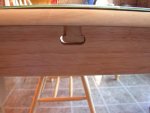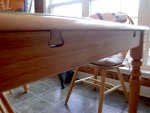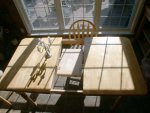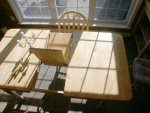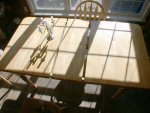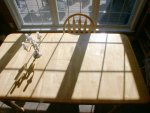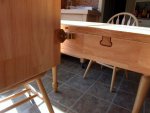Dave,
You don’t pick easy ones, do you?
I don’t have much of a feel for woodworking, but it is difficult for me to imagine that dovetails could sustain the moment at the ends of the stringers were the table picked up with leaves extended.
Any mechanism that would come out through the ends of the stringers seems to affect the clean lines of the table.
What I would do is this: (Assuming 6 ½” overlap of extended leaves & stringers.)
• Get some heavy extruded and anodized aluminum T-track.
• Mill a groove in two stringers to accept the track, stopping the groove about ½” short of each end. The groove would be slightly deeper than the height of the track.
• Remove by milling, the top legs of the track three inches each side of its center.
• Drill and countersink for screws along the length of the track.
• At the center of the track(s), drill a ½” dia. hole.
• At the center of the stringers, drill and tap ½-13 x ~ 2” deep.
• Using a fixture that keeps the top of the track flush with the top of the stringers, bed the track in epoxy. Cure.
• Screw the track down.
• Mill Delrin tee sections (4), about 5 5/8” inches long that are sized to fit the track sections in hand. Attach them to the inner ends of the sliding leaves.
Now, the sliding leaves can be dropped into the track, pulled out, and a ½-13 SHCS can be screwed into the center(s) of the track for a stop.
To further strengthen the tabletop, how about this?
• Make a 2 tube/1 rod sliding assembly that incorporates springpins and detents to keep the rod engaged to both tubes when extended.
• Take each of the edge pieces that run under the table parallel to the slide direction, and split in half with a bandsaw.
• Mill hemispherical grooves through them, again stopping short of the visible ends.
• Embed the ½” I.D. steel tubes into the grooves and glue each piece back together.
• After assembling the first leaf to the table, insert the two ½” dia. steel rods into the tubes, and push them all the way in.
• Assemble the second leaf to the table, pull the rods back from the first leaf, and engage the second. Now the rod will float between the two leaves.
• Construct the parts beneath the center leaf as a downwards facing C section, so the rod supports the leaf ends.
• If desired, a detent or lock could be used here as well.
I look forward to seeing both how the original is constructed and how real woodworkers approach this challenge.





